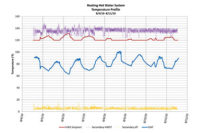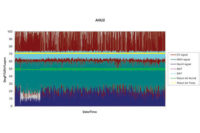This is the first in a series of columns in which I plan to demonstrate examples of systems performance information that can be gleaned from trend log analysis. Whether the trended data comes from a BAS or from portable dataloggers, the analysis is the same.
In these columns, I will introduce a system or sub-system, show a trend graph, and then leave it up to the reader to discover the operational “issue” illustrated in the graph. The answer will be given at the start of the subsequent month’s column.
SYSTEM
This month’s system serves an underground parking garage below a 124-unit condominium complex in a northern (cold) climate. It is a 100% outside air system with intake louver and damper, air filters, constant-wspeed fan, and modulating gas-fired heater. The makeup air unit is interlocked with an exhaust fan that removes slightly more air from the garage than is introduced by the makeup air unit (to keep the parking garage negative with respect to the adjacent occupied building).
The system is controlled based on both carbon monoxide (CO) and space temperature. If the space CO concentration rises above a maximum setpoint, the makeup air unit (and exhaust fan) energizes and operates until the CO concentration drops below its setpoint. If the wall-mounted thermostat senses a space temperature below its 60°F setpoint when the makeup air fan is on, the gas-fired burner will energize until the space temperature rises to its setpoint. If the space temperature falls below its setpoint when the makeup air unit is off, both the fan and the gas-fired burner will energize. When the space temperature rises to its setpoint, the gas-fired burner and the fan will stop.
This analysis was conducted because the condominium association was concerned by their exorbitant natural gas costs during the winter and the fact that the makeup air unit would run continuously for extended periods of time in the winter.
TRENDS
Portable dataloggers were placed in the following locations:
• In the outside air intake duct (temperature)
• In the discharge air duct (temperature)
• At the space thermostat (temperature)
• On the power wires to the makeup air fan (amps)
The data loggers were programmed to record readings every five minutes from December 18 to January 17.
TREND GRAPH
Table 1 diplays all of the trend data plotted together in a single graph.
ASSIGNMENT
What does this trend log tell us about why the makeup air unit was operating for extended periods of time and using so much natural gas? ES





